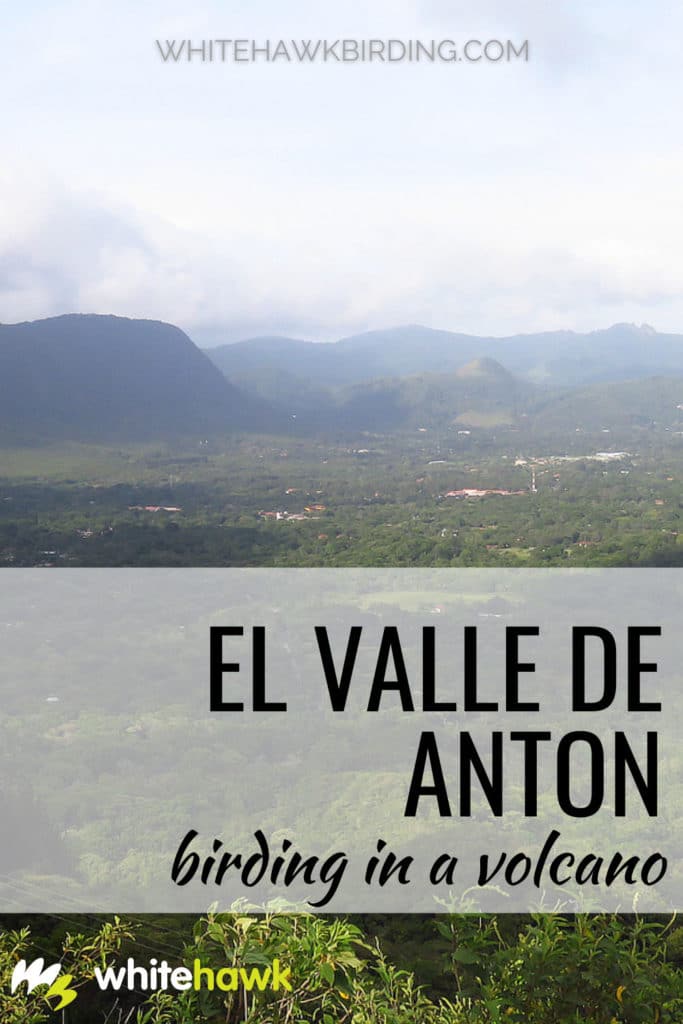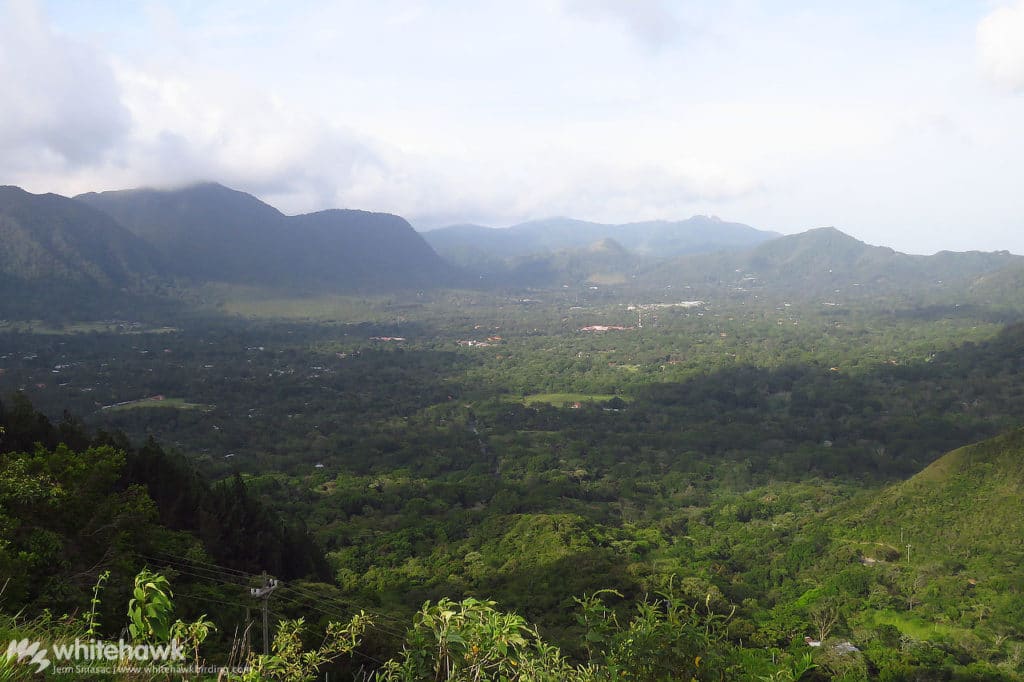
El Valle de Anton, located in Panama’s western foothills, is a true birder’s paradise. Birding in El Valle is among the best in all of Central America. It is also one of the most unique places in the world. An ancient volcano once towered over the land and sea. More than 200,000 years ago, it underwent a huge eruption. This caused the top of the volcano to collapse, forming a 6-km-wide caldera. Lava domes form the jagged rim of the crater. And the area is now covered in montane forest dripping with epiphytes and ferns. A bustling town of approximately 8000 inhabitants calls “El Valle” their home. El Valle is the only inhabited volcano crater in the western hemisphere.
Situated at 600 meters in elevation, El Valle is a popular tourist town. It hosts a bustling market, hot springs, trails, and natural beauty. However, one of El Valle’s biggest draws is its birds. Birding has been popular in El Valle for decades. Just about everywhere you look around town and its outskirts, birds are everywhere. And not just any birds – El Valle is home to some rather unique and sought-after Neotropical species.
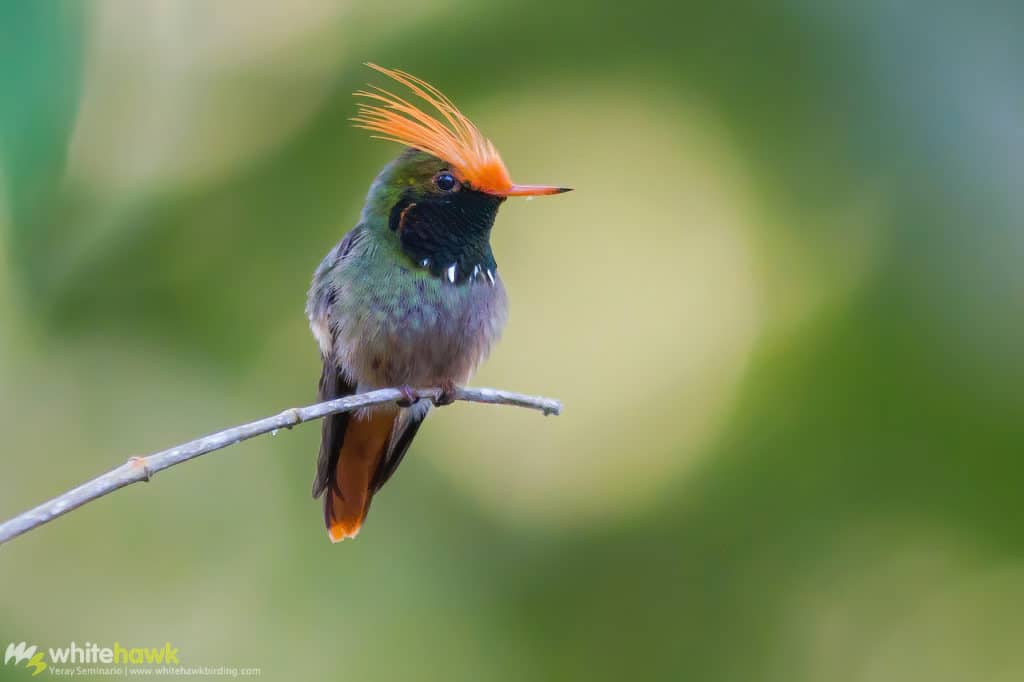
El Valle’s Birds
There is no shortage of birds to see in El Valle. It is a hotspot for foothill species. Here, birders can see a great variety of tanagers, hummingbirds, toucans, flycatchers, motmots, raptors and so much more. El Valle’s montane forests, forests edges, open fields, rushing streams, and quiet roadsides offer a nice mix of habitats and support great biodiversity. Even with a short stay, it is easy to rack up a good list of hundreds of species of birds in and around El Valle.
El Valle is home to several specialty species. That is, those that have restricted ranges, restricted habitats, are elusive or rare or are of just plain interest. Keen birders will often seek out the following birds during a visit to El Valle:
- Black-crowned Antpitta: It is one of only two species of Pittasoma. The Black-crowned Antpitta is a large and fantastic member of the gnateater family, Conopophagidae. Shaped like an antpitta with similar elusive habits, this bird is sure to impress with its stark black cap, chestnut back and wings, and heavily scalloped underparts. It hides out in the forest understory, where, in usual antpitta fashion, it walks along the ground in search of insects and other prey which it catches with its thick bill, hooked at the tip. The Black-crowned Antpitta inhabits mature forest in Costa Rica and Panama. El Valle is one of the best places to find it throughout its range.
- Streak-chested Antpitta: Like the Black-crowned Antpitta, the Streak-chested Antpitta, a true antpitta, also resides in the dark forest understory around El Valle de Anton. It is usually first detected by its mournful song consisting of a series of single notes.
- Collared (Orange-bellied) Trogon: The orange-bellied subspecies of the otherwise widespread Collared Trogon lives only in Panama and Costa Rica. In El Valle, there is no overlap with the red-bellied Collared Trogons. Listen along the quiet roadsides at higher elevations around El Valle for its 2-note song.
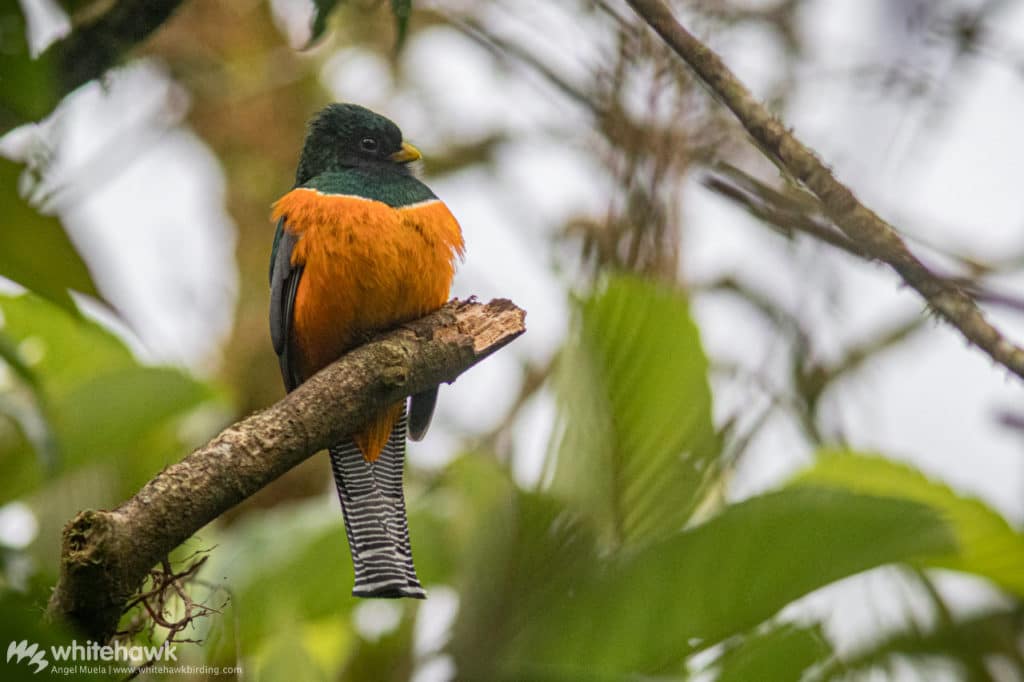
- Northern Emerald-Toucanet: This is the smallest, and arguably the most beautiful toucan of Central America. We can find this species in the quiet montane forests around El Valle. Its soft green plumage contrasts with a bold two-toned bill, and a sapphire throat enhances its beauty. This small toucan is formerly known as the “Blue-throated Toucanet.”
- Tody Motmot: El Valle is a prime place to search for the Tody Motmot. It is the smallest member of the well-known motmot family of the Neotropics. However, it lacks the distinctive rackets on the tail of all the other motmot species. It is a denizen of the dark ravines and forest understory in and around El Valle town, where it sits for long periods of time, occasionally wagging its tail.
- Rufous-vented Ground-Cuckoo: The “holy grail” of birds, the Neomorphus ground-cuckoos are a birder’s dream to see in the Neotropics. The roadrunner of the tropics, this species is one of only five in the genus. Rare and elusive, our best chances of seeing this species is at large army ant swarms. El Valle is a great place to seek out ant swarms with the hopes of seeing a spectacular Rufous-vented Ground-Cuckoo.
- Spot-crowned Barbet: El Valle is the northwestern-most part of the range-restricted Spot-crowned Barbet’s distribution. And it is a great place indeed to see this charming bird. We often see this bird in pairs. Males and females are similar in appearance, but males have a lovely soft lemon breast while females have black underparts.
- Spectacled Owl: While a widespread and common owl of the Neotropics, resident Spectacled Owls around El Valle are always a favorite to see. There is a long-standing pair of Spectacled Owls in El Valle, and others are regularly seen around town. Their large size and huge eyes capture all attention, even more so when the pair is seen perched together in the forest. Sometimes, a cotton-topped youngster is around!
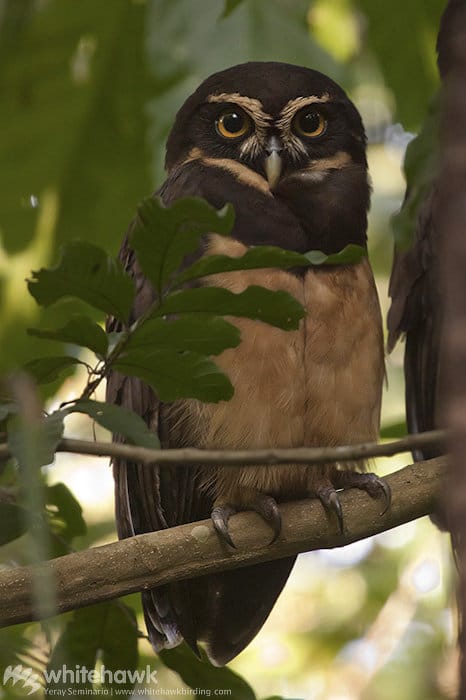
Mixed feeding flocks are a joy to find around El Valle. Foothills tanagers, euphonias, honeycreepers, wrens, jays, woodcreepers, antvireos, flycatchers, and more band together in search of fruits and insects in the forest midstory and canopy. Colorful tanagers – Silver-throated, Bay-headed, Tawny-crested, Black-and-yellow, Emerald, Blue-gray, Crimson-backed – bring to life all the colors of the rainbow. Coming across mixed feeding flocks are a great way to grow a list quickly, and a big flock will seem endless with birds.
Hummingbirds are also a highlight in El Valle. Birders have recorded Twenty-eight species in El Valle and the surrounding area. It is possible to see several foothills species such as Green Hermit, Violet-headed Hummingbird, Bronze-tailed Plumeleteer, Green Thorntail, White-tailed Emerald, Purple-throated Mountain-gem, Green-crowned Brilliant, and Crowned Woodnymph, along with the more widespread and lowland species. Hummingbirds of particular interest here include the tiny and spectacular Rufous-crested Coquette, the beautiful Snowcap, and the White-tipped Sicklebill with its outrageously downcurved bill.
Some notable raptors are worth keeping an eye out for in El Valle. At higher elevations around the rim of the crater we can look for graceful Swallow-tailed Kites and the uncommon Barred Hawk. In the forests, the resounding call of the Barred Forest-Falcon can be heard, and if lucky you may catch a look at this shy forest raptor.
In addition to all the birds, El Valle is also great for other animals. It is easy to see both Brown-throated Three-toed and Hoffmann’s Two-toed sloths, a favorite of many of our visitors. The forests around El Valle are also home to some rarer mammals including Rothschild’s Porcupine and Greater Grison. Squirrels, Geoffroy’s Tamarins, agoutis, and other mammals are home here. Reptiles and amphibians are abundant in and around El Valle. For snake enthusiasts, it is a good place to look for Eyelash Pit-Viper and other shy snakes. Frogs and toads are abundant after dark, and you can enjoy an evening frog chorus during the rainy season. It is the forests around El Valle that were once the home of the critically endangered Panamanian Golden Frog. Now extinct in the wild, but nonetheless a local and national symbol of biodiversity.
Birding Hotspots around El Valle
There are possibilities to go birding just about everywhere you go in El Valle and the surrounding area. The wide range of habitats provides home to hundreds of species of birds and other wildlife. Birding in El Valle is great because it is generally easy birding, with many walkable roads and easily accessible trails. The scenery is simply beautiful. It is relatively easy to access Altos del Maria from El Valle. Plus, El Valle is in good proximity to Panama City. Birding here can be done as a day trip or multi-day trip, with enough activity to keep birders busy here for weeks. Here is a brief overview of some of the places we like to go birding in and around El Valle:
Las Minas Road: The semi-open road to Las Minas starts on your left when arriving at La Mesa. This quiet road (only accessible by foot) is bordered by open fields and montane forest along its length. Here we like to watch for mixed feeding flocks with Silver-throated, Bay-headed, and Golden-hooded tanagers, as well as Tawny-capped Euphonias and other small forest birds. Tawny-crested Tanagers pass through here in large flocks. We often see Black-chested Jays along the road. It is possible to see Black-crowned Antpitta, Northern Emerald-Toucanet, and Collared (Orange-bellied) Trogon here, along with so many others.
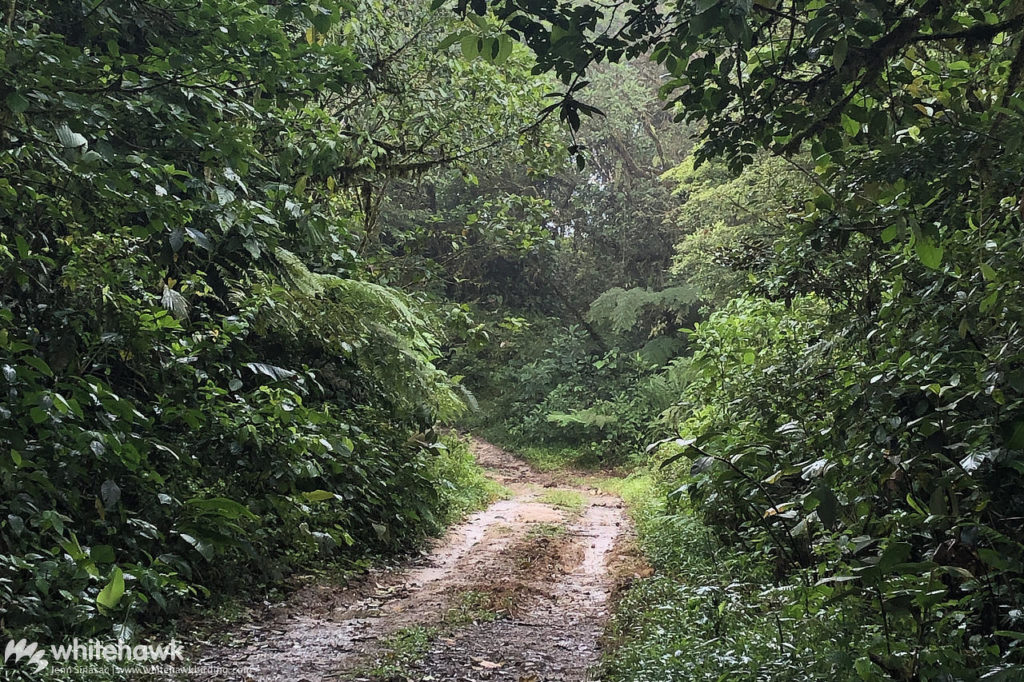
La Mesa: La Mesa (tablelands) is a flat area on the northeastern side of the rim of the crater, and is known for the chicken farms that cover the area. The quiet roads, many bordered by good montane forest, are a great place to look for middle-elevation species including Spotted Woodcreeper, Spot-crowned Barbet, Rufous Motmot, Chestnut-capped Warbler, Flame-rumped Tanager, Stripe-throated Hermit, Tawny-faced Gnatwren, Dusky-faced Tanager, White-lined Tanager, Lesser Goldfinch, and many others. Large army ant swarms here often attract Rufous-vented Ground-Cuckoos, and we keep an eye out along streams for Sunbittern!
Cerro Gaital National Monument: The montane forest that blankets the northern rim of the El Valle crater forms the Cerro Gaital National Monument, a part of a network of protected natural areas found across Panama. Cerro Gaital is a great place to find Black-faced Grosbeak, Green Hermit, Green-crowned Brilliant, White-tipped Sicklebill, Northern Schiffornis, Olive-striped Flycatcher, White-ruffed Manakin, Scale-crested Pygmy-Tyrant, Barred Forest-Falcon, Red-crowned Ant-Tanager, and Swallow-tailed Kite. The trails wind through dense cloud forest with surprises around every corner!
Candelario Trail: Tucked in a quiet corner of La Mesa, the trail network at Finca Candelario is a birder’s paradise. Highlights here include White-tipped Sicklebill, Plain Antvireo, Slaty Antwren, Brown-billed Scythebill, Streak-chested Antpitta, and good chances for army ant swarms where even Rufous-vented Ground-Cuckoos can be seen attending the feeding frenzy. Even the rare Crimson-bellied Woodpecker has been reported here!
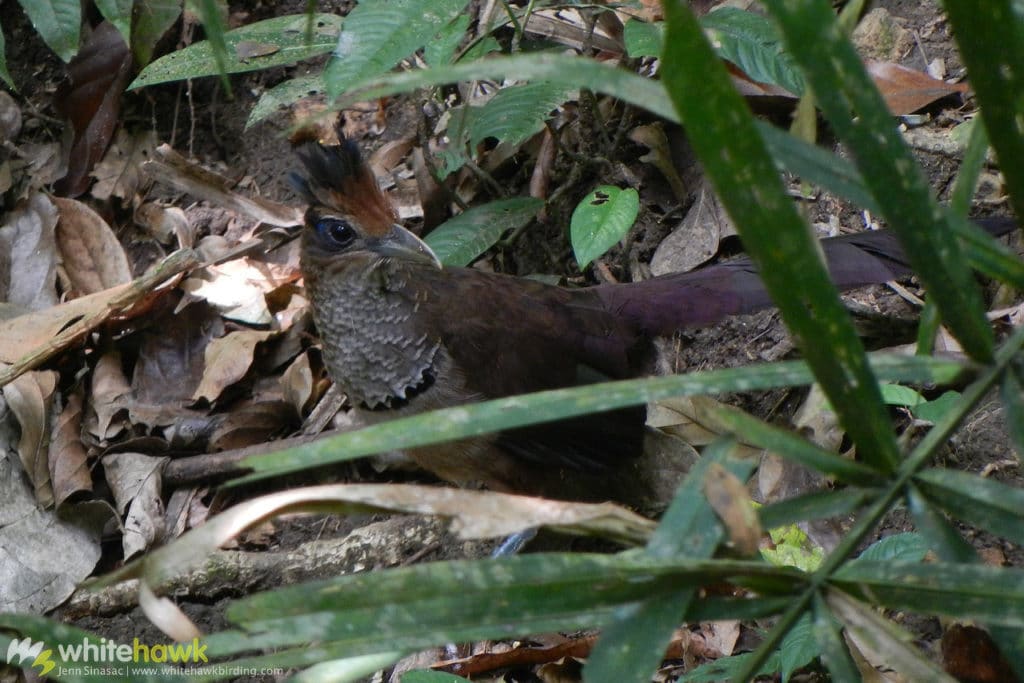
Cara Iguana Road: Despite El Valle’s small size, it is possible to reach productive patches of dry forest. Tucked in at the base of Cerro Cariguana, the quiet ravines and dry, shrubby roadsides provide great habitat for a number of birds. We can find Tody Motmot, Lance-tailed Manakin, Rufous-and-white Wren, Garden Emerald, Barred Antshrike, and Lesson’s Motmot and more. We can also keep our eyes out for White Hawk, White-winged Becard, Lineated Woodpecker and Streaked Flycatcher. A well-known property here is home to a pair of Spectacled Owls. These owls have been breeding here for nearly a decade, giving great opportunities to see this large and spectacular owl. Cara Iguana Road is always worth a stop when birding in El Valle.
Altos del Maria: Altos del Maria is the highest elevation point on the Eastern rim of the El Valle crater, and the highest elevation we can reach not far from the town. In areas above 1,100 m, particularly in the Valle Bonito area, we can find some higher elevation foothills species. The quiet cloud forests of this area are good places to find Black Guan, Brown-billed Scythebill, Elegant Euphonia, Smoky-brown Woodpecker, Rufous-browed Tyrannulet, and rarities including Scaled Antpitta and Crimson-bellied Woodpecker. It is also a great place to see Barred Hawk, Ornate Hawk-Eagle, Russet Antshrike, Bran-colored Flycatcher, Green Hermit, Northern Emerald-Toucanet, Scarlet-thighed Dacnis, Dull-mantled Antbird, Collared (Orange-bellied) Trogon, and Purplish-backed Quail-Dove, to name a few. We can encounter a whole suite of montane foothill species here, always making for a fantastic day of birding!
A little further outside of El Valle, the vast Pacific lowlands of Panama stretch along the coastline. These very dry habitats consist of open fields, scrubby forests, coastal mangroves, and periodically flooded rice fields. All are great places to seek out Pacific lowland birds restricted to this region. This is the only area in which we can find the Veraguan Mango, a near-endemic of Panama.
Crested Bobwhite, Straight-billed Woodcreeper, Pale-breasted Spinetail, Pale-eyed Pygmy-Tyrant, Northern Scrub-Flycatcher, Sapphire-throated Hummingbird, Plain-breasted Ground Dove, Yellow-crowned Parrot, and Brown-throated Parakeet are other species we hope to see here. Savanna Hawk, Great Black Hawk, Aplomado Falcon, Pearl Kite, Crested and Yellow-headed caracaras, Lesser Yellow-headed Vulture, and others often scour the open fields in search of their next meals. Waders and shorebirds are abundant. When conditions are favorable, we can often see a wide array of herons, ibis, storks, and plovers, too. A trip down to the lowlands when birding in El Valle will increase trip lists and provide some new and different species than those found in the foothills.
These are just a few of our favorite places to bird around El Valle. Be sure to check out eBird for even more birding hotspots.
Location, Location, Location!
El Valle is in Coclé province in western Panama. A 2-hour drive from Panama City will bring you to the lush, birdy foothills of El Valle. Once you arrive, you will be surrounded by nature, ready to take in all the birds and wildlife around you. The nice thing about birding in El Valle is that you can visit a wide variety of habitats and elevations in a small area, maximizing your birding experience there. From dry forest to humid montane cloud forest, open volcanic plateau to Pacific lowland wetlands, the possibilities are endless!
Getting to El Valle is simple. From Panama City, head west on the Pan-American Highway. After passing through the town of San Carlos, you will take a turn right at the town of Las Uvas. From here you will increase in elevation, from sea level to approximately 800 m. The scenery changes from dry lowlands to lush hillsides and volcanic barren lands as you approach the town. The final descent into the town will give you a glimpse of the size of the enormous caldera. You’ll arrive in town and immediately get a feel for the bustling local life in this mountainous setting. Now it’s time to start birding!
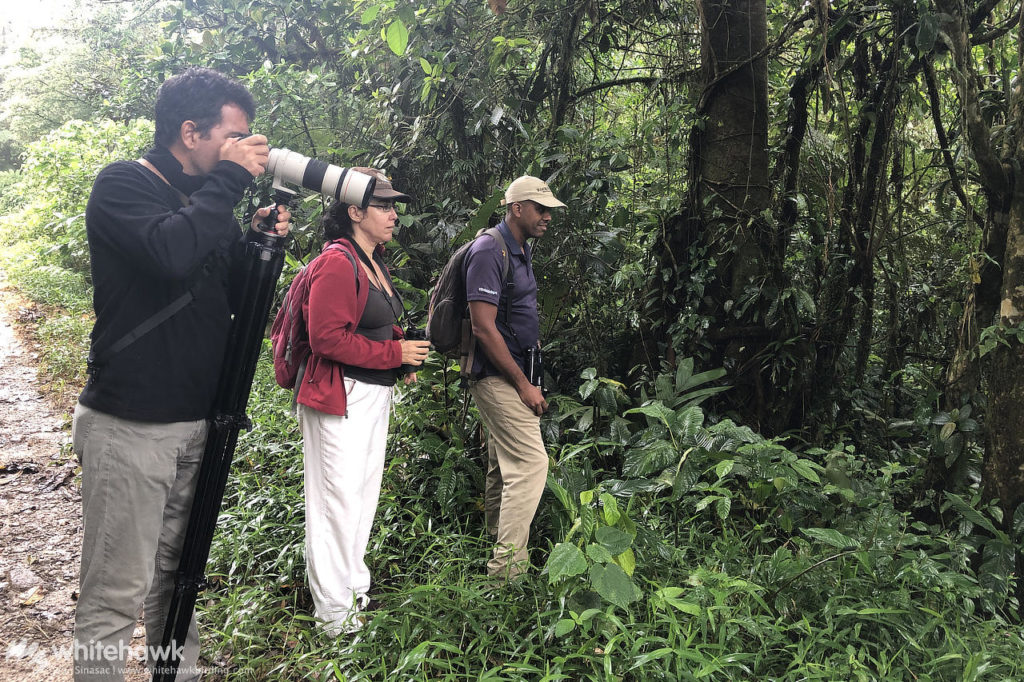
Let’s go birding in El Valle!
Interested in birding in El Valle? We offer full-day trips from Panama City and guided birding tours to the best birding areas this region has to offer. One day will give you a good introduction to birding in the western foothills, but if you really want to get the full experience, we recommend staying at least a few days and exploring the area in more depth. Contact us for more information!
